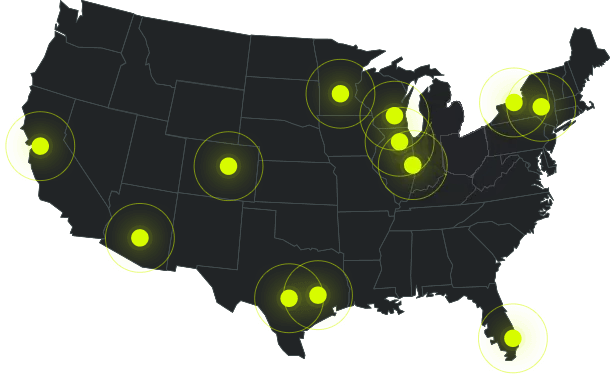
Multi Jet Fusion (MJF) is quickly becoming a popular choice for 3D printed prototypes and production parts. MJF can be used to make enclosures, electronics housings, complex ducts, lattice structures, and functional assemblies. The technology is capable of 3D printing parts with high detail, as well as suitable for applications that require durability (e.g., snap fits). MJF is also a common choice for short production runs. MJF 3D printing is one of many technologies in Fathom’s comprehensive additive manufacturing services.
MJF parts start with a thin layer of powder spread across the print bed. The inkjet array in the print carriage sweeps over the print bed, jetting two agents downward into the powder—a fusing agent and a detailing agent. The fusing agent is used to fuse the powder together and the detailing agent is used to reduce fusing at the part boundary in order to achieve greater detail. After the print carriage finishes a pass, the build platform is lowered, more powder is added, and the process starts again.
Parts with smooth surfaces and complex, intricate features can be manufactured using Multi Jet Fusion. Other applications include //
| STANDARD MJF MATERIAL |
LEAD TIME | OPTIMAL QUANTITY |
MAXIMUM DIMENSIONS | SUGGESTED MINIMUM WALL THICKNESS |
FINISH & APPEARANCE |
ADVANTAGES & CONSIDERATIONS |
|---|---|---|---|---|---|---|
| Nylon 12 (Gray or Dyed Black) | 2+ Days | Prototypes, Low-Volume, Short-Run Production | 274mm x 370mm x 360mm | 1mm |
|
|
Nylon 12 is a commonly used thermoplastic that is strong enough for functional, small- to medium-size, prototyping and production parts. Nylon 12 is ideal for complex assemblies, housings, enclosures, and watertight applications. Achieve smooth surfaces and fine details with this durable material. Nylon 12 provides excellent chemical resistance to oils, greases, aliphatic hydrocarbons, and alkalis. Parts produced are a non-uniform light gray, but can be dyed a darker color for a uniform appearance.
Nylon 11 for MJF is also available upon request. Talk to a Fathom expert to learn more!
AMT’s PostPro3D technology is an automated post processing solution for smoothing 3D printed parts made with MJF. PostPro3D achieves a high quality surface finish that matches injection molding techniques when using 3D printing processes. This technology reduces lead-time, cost of manufacture, operational and maintenance costs while providing the ‘missing piece’ in the digital manufacturing chain. The PostPro3D machine makes 3D part surface finishing speed and cost competitive for high volume production.
Talk to an expert at Fathom today to take your parts to the next level using AMT PostPro3D for post processing.


Is MJF the right 3D printing technology for your next project? Learn more about the benefits and limitations of MJF below.
MJF and Selective Laser Sintering (SLS) both build parts out of a powder bed. SLS uses a powerful CO2 laser to sinter or fuse cross sections of the part. The platform shifts down one layer, powder is spread across the build platform, and the process repeats until the part has been made. The part is then excavated out of the powder bed after it has cooled.
MJF and SLS both use thermoplastic polymer powder material, however, there are a few key differences. The primary difference is the source of heat used during the process. SLS uses a powerful laser to heat each cross-section. MJF uses a fusing agent (ink) distributed onto the powder while an infrared light passes over the platform, curing the photosensitive ink that has fused with the powdered plastic. Fusing during MJF happens in a line while SLS fuses each cross-section point by point. The excess unused material in both technologies can be salvaged and recycled – but a greater amount is retrieved when using MJF. Post processing and finish can vary depending on the technology utilized. SLS parts are printed in white and then dyed. They may also be gray. MJF parts are printed in light gray and can be dyed black. Both technologies end up with a grainy finish, but can achieve a very smooth finish during post-processing.
Q // Who Invented Multi Jet Fusion?
A // Multi Jet Fusion was developed by Hewlett-Packard (HP).
Q // What Geometries Can Be Achieved With Multi Jet Fusion?
A // Parts that require internal cavities and complex geometries can be made using Multi Jet Fusion.
Q // What Color Options and Surface Finishes Are Available?
A // Parts produced are a non-uniform light gray and can be dyed in dark colors to achieve a uniform appearance. Choosing to dye parts will extend lead-time. These parts will feel grainy, similar to other power-based systems such as SLS, but can be smoothed further in post processing if desired.
Q // What Are Part Size Limitations?
A // The bounding box of the MJF 3D printing system is 284 mm x 380 mm x 380 mm (11.18 in. x 14.96 in. x 14.96 in.). Larger parts can be split and glued together during post processing.
Q // What Is The Standard Accuracy, Layer Height, and Minimum Feature Or All Size?
A // Expect an accuracy of +/-0.3 mm up to 100 mm or +/-0.003 mm per mm beyond 100 mm. The layer height is 80 microns. Fathom recommends a wall thickness minimum of 1 mm.
Q // What Is The Minimum Gap/Hole Size? Can You Tap Threads? What Is The Minimum Thread Size?
A // Minimum gap is typically 0.5 mm between features. Fathom suggests using threaded inserts for anything under ¼-20 threads when tapping threads.
Get An Instant 3D Printing Quote on Any MJF Project Today.
